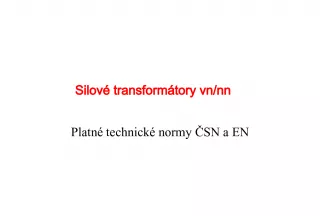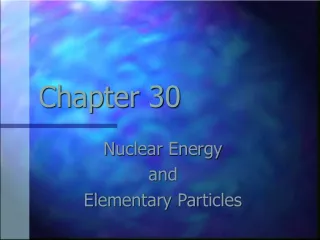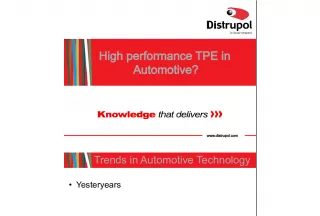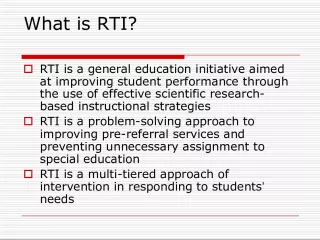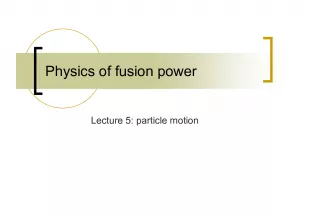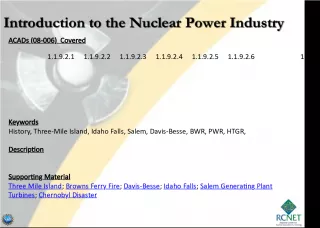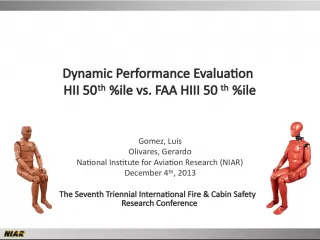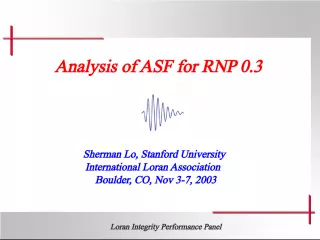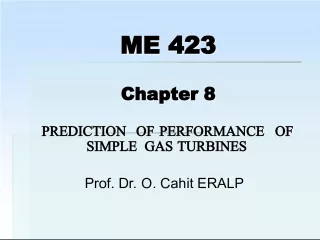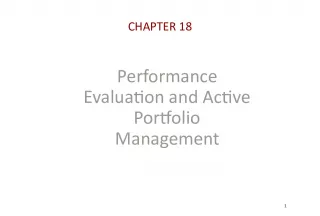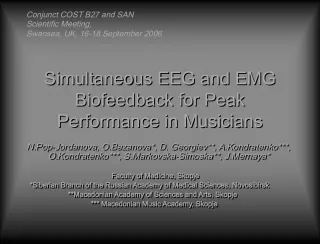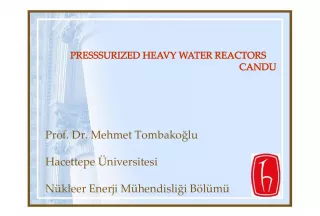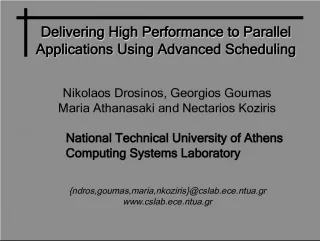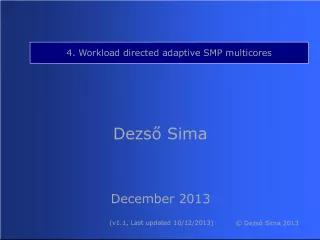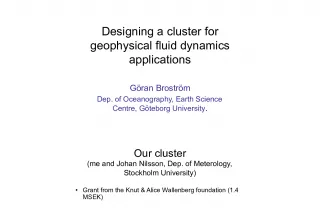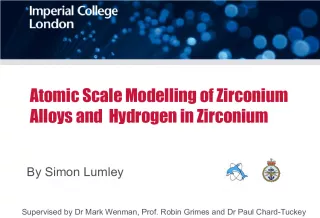Fabrication and performance of Li4SiO4 pebbles for fusion reactors
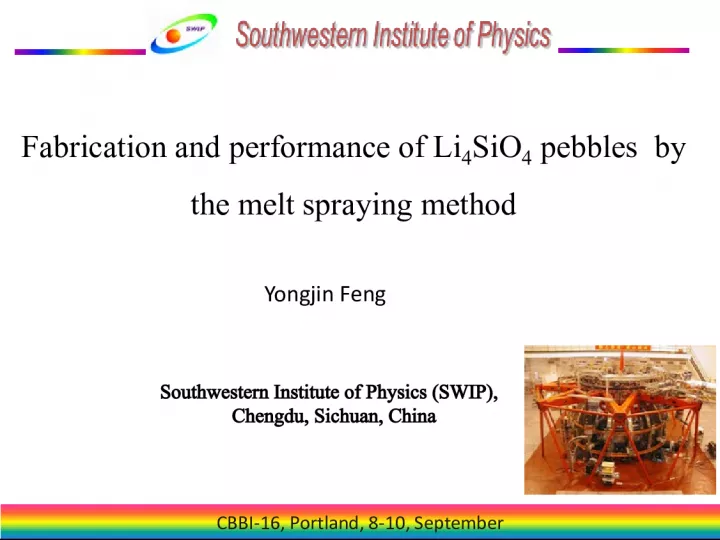

This presentation will cover the fabrication process and results of Li4SiO4 pebbles as breeder materials in fusion reactors. It will also discuss deuterium retention and desorption behavior, as well as plans for future research at SWIP.
- Uploaded on | 0 Views
-
 clare
clare
About Fabrication and performance of Li4SiO4 pebbles for fusion reactors
PowerPoint presentation about 'Fabrication and performance of Li4SiO4 pebbles for fusion reactors'. This presentation describes the topic on This presentation will cover the fabrication process and results of Li4SiO4 pebbles as breeder materials in fusion reactors. It will also discuss deuterium retention and desorption behavior, as well as plans for future research at SWIP.. The key topics included in this slideshow are Li4SiO4, fusion reactors, breeder materials, deuterium retention, SWIP,. Download this presentation absolutely free.
Presentation Transcript
1. CBBI-16, Portland, 8-10, September Fabrication and performance of Li 4 SiO 4 pebbles by the melt spraying method Yongjin Feng Southwestern Institute of Physics (SWIP), Chengdu, Sichuan, China
2. CBBI-16, Portland, 8-10, September Background Fabrication Process and Results of Li 4 SiO 4 pebbles Deuterium Retention and Desorption Behavior of Li 4 SiO 4 R&D Plans on Breeder Materials at SWIP Summary Outlines
3. CBBI-16, Portland, 8-10, September CN Helium Cooled Ceramic Breeder (HCCB) TBM designs based on the SB/He/FM concept. 1. Background Explosive view of CN HCCB TBM Sub-module design Be pebbles by REP method 1-ton Ingot of CLF-1 Component Material Structure RAFM Coolant He Purge gas He+0.1%H 2 Neutron multiplier Be Breeder Li 4 SiO 4 , Li 2 TiO 3
4. CBBI-16, Portland, 8-10, September The ceramic breeder material must satisfy the following requirements: High tritium breeding capability; Adequate mechanical properties; Limited pebble fragmentation ; Adequate pebble bed thermal conductivity; Compatibility with ferritic steel and the purge gas; Chemical stability to avoid mass transport and material restructuring; Radiation resistance; Low tritium residence time; Low activation;
5. CBBI-16, Portland, 8-10, September The fabrication trials have been investigated, such as, Melt spraying method, Freezing-Sintering method, Extrusion-spheronization-sintering, Sol-gel. The pebbles produced by the melt-spraying method have several advantages: Higher density; Smooth surface; Higher sphericity; Less contamination source; Simpler reprocessing. The selection of fabrication process for the pebbles based on the following criteria: Capability to meet the pebbles goal specifications adequate for the HCCB TBM; Simplicity and economics; Scalability to industrial range; Sufficient production yield; Conveniently recycling the unburned 6 Li from the pebbles.
6. CBBI-16, Portland, 8-10, September Schematic drawing of fabrication setup Heating and insulation Melting pot Bottom feeder Gas jet sprayer 2. Fabrication process and Results Fabrication facility Raw materials: Li 2 CO 3 (Purity:99.99%) SiO 2 (Purity:99.99 ) Li/Si Molar ratio: 4 Melting Pot: Corundum Crucible The raw materials are melted at temperature of about 1400 . Gas pressure: 1.5 bar, Gas: Nitrogen, Falling distance: 3.5 m. Heat treatment condition: 1000 , 2h Production: 100Kg/year pebbles with 1.0 mm diameter
7. CBBI-16, Portland, 8-10, September Optical micrographs and SEM Most of the pebbles are well spherically shaped, smooth surface. Shape and surface structure Optical micrographs and SEM of the pebbles with 1mm diameter SEM of pebbles surface Broad size distribution.
8. CBBI-16, Portland, 8-10, September Phase analysis Heat treatment atmosphere: Vacuum, air temperature: 1000 time: 2h XRD pattern of pebbles annealed at air The diffraction peaks of Li 2 CO 3 , Li 2 SiO 3 ,Li 4 SiO 4 are observed. Carbon dioxide are easily absorbed by Li 4 SiO 4 XRD pattern of pebbles annealed at vacuum Li 4 SiO 4 as the major phase, Li 2 SiO 3 as a second phase TG curve of Li 4 SiO 4 at CO 2 atmosphere Temp. <500 absorb rate very slow; 500 < Temp.< 720 absorption obviously; 720 < Temp.< 900 CO 2 desorption
9. CBBI-16, Portland, 8-10, September Thermal analysis The weight loss of about 40% occurred between 550 and 800 . the significant weight lost taking place at 720 . The reaction is a endothermic reaction. Thermoanalysis of mixed raw materials DSC TG Mass change:-41.67% 716.7 Physical properties Measurement of Density and porosity by Hg- porosimetry and He-pycnometry. Specific surface area measurement by a multipoint BET method. Initial state After Heat treatment Density (% TD) ~ 93.5 ~ 94 Open porosity (%) ~ 5.7 ~ 5.2 Closed porosity(%) ~ 0.8 ~ 0.75 Specific surface area (m 2 /g) 2.796 1.095 Total pore volume for pores (cc/g) 3.403e-03 2.012e-03
10. CBBI-16, Portland, 8-10, September Behavior in air Pebbles were exposed to air for 50 days at room temperature. The influence of the exposed surface area on the rate of uptake was measured. The uptake of moisture was determined by the weight increase. Weight increase of initial state pebbles and after annealing pebbles. Chemical Composition of pebbles The amount of impurities are 0.116186% Li/Si molar ratio 4 Elements analysis by ICP-OES
11. CBBI-16, Portland, 8-10, September Mechanical properties Mechanical stability analysis by crush load tests. Single sphere was placed between two parallel plates. A continuously increasing load is imposed by a piston to a single pebble until it breaks. 40 pebbles with a diameter ~1.0 mm were tested, respectively. Initial state After Heat treatment Max. load (N) 12 16 Min. load (N) 4.3 5.2 Average load (N) 6.5 7.0 After heat treatment , the crush load increased. The value is scattered. The mechanical stability must be improved. pebble press
12. CBBI-16, Portland, 8-10, September 3. Deuterium Retention and Desorption Behavior The elucidation of tritium recovery from Li 4 SiO 4 is one of key issues of TBM design. The study of hydrogen isotopes behavior in solid breeder materials is a important subject in the design for D-T fusion blanket module. D 2 irradiation has been applied as a technique of hydrogen isotopes implantation. Deuterium ion implantation was used to induce hydrogen isotopes and other irradiation defects into the surface of irradiated breeder material. Desorption of hydrogen isotopes as water forms and hydrogen molecular forms might be due to the existence states of hydrogen isotopes on the surface of irradiated breeder material. In Shizuoka University of Japan, the X-ray Photoelectron Spectroscopy (XPS) and Thermal Desorption Spectroscopy (TDS) apparatuses can be utilized for the elucidation of D 2 desorption behavior in solid breeding materials.
13. CBBI-16, Portland, 8-10, September 13 Experimental procedures of D 2 + implantation TDS TDS Heating rate: 5 K min -1 Heating region: R.T. - 10 00 K Heating treatment Heating treatment Heating temperature: 10 00 K Heating time: 10 min Ion energy: 3.0 keV D 2 + Ion flu ence : (0 .4, 0.6, 0.8, 1.0 ) 10 22 D + m -2 Ion flux: 2 .010 18 D + m -2 s -1 Implantation temperature: R.T. XPS XPS D 2 + Imp. D 2 + Imp. X-ray source: K of Al XPS XPS Sintering Temperature: 1173 K Heating time: 3 h
14. CBBI-16, Portland, 8-10, September Atom Li: 55.6 eV Li- O - : 53.3 eV Li-1s XPS spectra Si - O - : 107.1 eV Si-O-D : 10 5 .2 eV Si-2p XPS spectra O - Si : 536.1e V D -O - D : 533. 8 eV - O-D : 531.3eV O-1s XPS spectra XPS results Comparision of before implanation and after implanation
15. CBBI-16, Portland, 8-10, September After TDS, the BE of electron for Li-1s,O-1s and Si-2p shift back to before implantation. The irradiated influence for the chemical state of Li-1s,O-1s and Si-2p in Li 4 SiO 4 will be recovered after TDS. Li-1s XPS spectra Si-2p XPS spectra O-1s XPS spectra Comparision of before implanation and after implanation
16. CBBI-16, Portland, 8-10, September TDS spectra of D 2 for Li 4 SiO 4 at different fluence TDS results D 2 desorption rate and the total D 2 retention increase with the increasing of implantation fluence. All of D + are trapped by oxygen vacancy to form OD bond. Peak analysis for TDS spectrum at the fluence 1.010 22 D m -2 The D 2 TDS spectrum of Li 4 SiO 4 can be divided into 3 peaks. The first is due to the material surface adsorption, the second could be from the defects caused by D 2 + implantation, and the third would be from O-D bond. The D 2 TDS spectrum of Li 4 SiO 4 can be divided into 3 peaks. The first is due to the material surface adsorption, the second could be from the defects caused by D 2 + implantation, and the third would be from O-D bond. D 2 retention of Li 4 SiO 4 at different fluence Peak 1 (400 K) Surface adsorption Peak 2 (500 K) Defect Peak 3 (650 K) -O-D- bond
17. CBBI-16, Portland, 8-10, September 4. R&D Plans on Breeder Materials For Fabrication: LiOH and SiO 2 will be used as raw materials, and compared with the current raw materials, the heat treatment will be optimized; The reprocessing of Li 4 SiO 4 pebbles will be considered by remelting; Li 2 TiO 3 pebbles shall be produced using Extrusion-spheronization- sintering method. For the properties of pebbles: Long-term annealing experiments under ITER TBM (DEMO blanket) relevant temperature and atmosphere; (Li content of the pebbles, Phase composition, microstructure, density, etc) Mechanical stability analysis will be tested as heat cycle test. After the tests, the amount of broken particles are determined. (Temperature : 200-600 , number of cycles: ~100 cycle (~1cycle/h) ).
18. CBBI-16, Portland, 8-10, September Irradiation properties of pebbles: Tritium behavior in thermal neutron irradiated Li 4 SiO 4 will be considered to carry out in this year; ( Temp. : < 353 K, T. N. flux: 5.510 12 cm 2 s -1 , T. N. fluence: 3.310 15 cm 2 ) Effect of implantation temperature on retention behavior of deuterium in Li 4 SiO 4 will plan to investigate. Thermo-mechanical of pebble bed Uniaxial compression tests at temperatures up to 900 to determine the mechanical characteristics of pebble beds will be performed. (Stress-strain dependence during stress increase and decrease, thermal creep strain at constant stress levels. ) Thermal conductivity measurements of pebbles bed and the effect of thermal creep on the thermal conductivity will be performed. (Tests in helium and air atmosphere and temperatures up to 900 )
19. CBBI-16, Portland, 8-10, September 5. Summary A melt-spraying fabrication process for Li 4 SiO 4 pebbles has been developed. Li 4 SiO 4 pebbles produced by spray of liquid droplets have almost spherical shape, a smooth surface and high density, but the produced pebbles exhibit a broad size distribution that limits the yield. The mechanical stability of different batches are scattered. This would endanger the safety of TBM, and also does not satisfy the requirements of TBM. A series of tests with pebbles of different composition treated in an optimized heat treatment conditions will be performed in our following work. Optimized process is undergoing at SWIP. It was confirmed that the new chemical states of lithium, oxygen and silicon on the surface of D 2 + -irradiated Li 4 SiO 4 was formed due to typical irradiation defects induced by D 2 + -irradiation. Thermo-mechanical behavior, long-term stability, the behavior under neutron irradiation and the tritium release properties will be performed.
20. CBBI-16, Portland, 8-10, September
